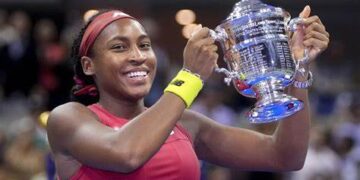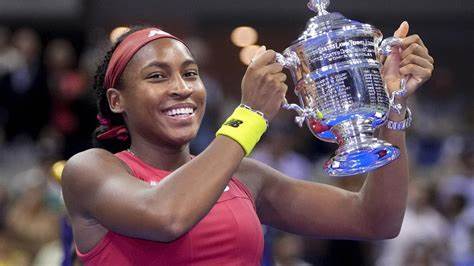INTRODUCTION:
In the world of professional sports, gender disparity in earnings has been a long-standing issue. Recently, a comparison between the earnings of athletes from different sports has sparked further conversation about the state of women’s sports and the financial realities faced by female athletes. The contrast is striking: Caitlin Clark, the basketball phenom from Iowa, made $80,000 this past season, while professional golfer Nelly Korda earned a staggering $4.4 million in prize money. Yet, despite these figures, tennis star Coco Gauff, over the span of just one week, managed to earn more than both of them combined.
This intriguing comparison has opened up a broader discussion about the Women’s Tennis Association (WTA) and its place in the sports world. How has tennis managed to achieve a more equitable financial landscape for female athletes compared to other sports? And what does it say about the future of women’s sports in general?
A Closer Look at the Earnings Disparity
The figures speak volumes about the vast discrepancies in earnings across different sports, especially for women. Caitlin Clark, who has dominated women’s college basketball with her unmatched skills and record-breaking performances, earned $80,000 this season. This is a respectable sum, but it pales in comparison to the multi-million-dollar contracts and endorsement deals enjoyed by some of her male counterparts. Furthermore, despite the growing popularity of women’s basketball, the professional women’s leagues and NCAA earnings have yet to catch up to the financial success of their male counterparts.
On the other hand, Nelly Korda, one of the top players in the LPGA (Ladies Professional Golf Association), earned a staggering $4.4 million in prize money in a single season. Korda’s earnings reflect the top-tier nature of the sport and the lucrative opportunities available to elite players. However, even with such impressive figures, women’s golf still lags behind men’s golf in terms of overall earnings and media attention.
Then there’s Coco Gauff, the young tennis sensation who has captivated the world with her talent and determination. Over just one week, Gauff earned more than both Clark and Korda combined, thanks to her success in major tournaments and the significant endorsement deals she has secured. Gauff’s rapid rise to the top of the tennis world has positioned her as one of the highest-paid athletes in women’s sports.
The WTA’s Financial Landscape: Why Tennis Is Ahead of the Game
The WTA’s ability to offer higher earnings compared to many other women’s sports can be attributed to several factors. Tennis is one of the few major sports where women have achieved prize money equality in Grand Slam events. Since the 2000s, the four major tennis tournaments—Wimbledon, the US Open, the French Open, and the Australian Open—have ensured equal prize money for both male and female players. This groundbreaking step has set tennis apart from most other sports, where gender disparities remain a significant issue.
In addition to equal prize money, tennis also benefits from global visibility. The WTA has established a prominent presence across continents, with major tournaments in countries such as the United States, the United Kingdom, and Australia. This global platform ensures that tennis players, especially those at the top of their game like Gauff, enjoy a high level of media exposure and endorsement opportunities. The widespread appeal of tennis also means that top players can command larger endorsement deals with major brands, further boosting their income.
Coco Gauff’s financial success can also be attributed to her marketability. At just 19 years old, Gauff is already a household name, and her presence on social media, along with her positive, inspiring image, makes her highly appealing to sponsors. Her rapid rise in the sport, coupled with her maturity on and off the court, has made her one of the most marketable athletes in the world today. This is a stark contrast to other female athletes, like Clark and Korda, who are still working to gain similar visibility in their respective sports.
Women’s Sports: The Growing Gap and Opportunities for Change
While the success of the WTA and players like Gauff is undeniably impressive, the disparities in earnings between female athletes in different sports highlight the work that still needs to be done. For instance, despite its global reach, women’s basketball still faces challenges in securing equal financial rewards for its players. The WNBA, while growing in popularity, still struggles with lower salaries compared to the NBA, and many college players like Caitlin Clark have limited earning potential until they transition to professional leagues, where pay and sponsorship deals are not on par with men’s sports.
Golf, though more financially lucrative than basketball, still suffers from a gender gap. The LPGA offers fewer prize money opportunities than the PGA Tour, and while Korda’s earnings are impressive, she is still an outlier in a sport where male golfers earn significantly more. This underlines the need for structural changes in how women’s sports are promoted and compensated.
What the Future Holds for Women’s Sports
The earnings disparity between athletes like Caitlin Clark, Nelly Korda, and Coco Gauff reflects the broader challenges women’s sports face in achieving financial equity. While tennis has made significant strides, other sports are still working to bridge the gap. However, there is hope on the horizon.
The growing visibility of women’s sports, paired with increasing sponsorship deals and media coverage, suggests that the landscape is shifting. As more fans tune in to women’s basketball, golf, and tennis, and as female athletes like Gauff, Clark, and Korda continue to break records and inspire future generations, the financial tide will hopefully continue to rise for all.
The WTA’s ability to provide equitable earnings for its athletes shows that gender parity is possible in sports. However, for real change to take place across all sports, a concerted effort is required to invest in and promote women’s leagues and competitions. Equal prize money, increased sponsorships, and more media coverage will help level the playing field for women in all sports.
Conclusion
The comparison of earnings between Caitlin Clark, Nelly Korda, and Coco Gauff highlights the progress and challenges faced by female athletes across different sports. While tennis, with its commitment to equal prize money and widespread global recognition, stands as a model for women’s sports, other disciplines must work to close the financial gap. As the success of athletes like Gauff continues to shine, there’s hope that women’s sports will continue to rise, bringing greater equity and opportunity to athletes everywhere. For now, the WTA remains at the forefront, offering a promising glimpse into the future of women’s athletics.
























